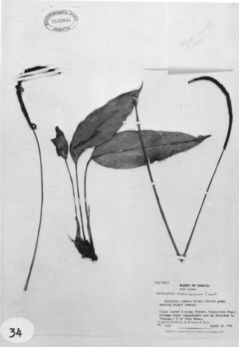




Anthurium cuasicanum Croat, sp. nov.
TYPE: Panama. Darien: Serrania Pirre, Cuasi-Cana Trail between Cerro Campamiento and La Escalera to "Paramo" of Tres Bocas, Kirk-bride & Duke 1267 (MO 2132030, holotype; NY, isotype).
Planta epiphytica; cataphyllum findens persistens in fibris tenuibus; petiolus teres aut obtuse aut anguste sulcatus, 3-13 cm longus; lamina subcoriacea, anguste lanceolata, raro anguste oblongo-elliptica; basi obtusa ad anguste subrotundata, raro acuta, (6.5-)8-16.5 cm longa, (1.5-)2.8-5.3 cm lata, utrinque conspicue glanduloso-punctata; inflorescentia foliis longiora; pedunculus teres, 22-35 cm longus; spatha viridis, interdum suffusa rubra, lanceolata, 2.5 cm aut longior; spadix viridis aut rubens aut brunneus, 6-13 cm longus; baccae plus minusve globosae, aurantiacae, 5-6 mm diam.
Epiphyte; stem short, 1 cm diam.; internodes short; roots relatively few, slender; cataphylls promptly weathering to fine, tan, persistent fibers.
LEAVES more or less erect; petioles terete or obtusely or narrowly sulcate, 3-13 cm long, usually two-thirds to three-fourths as long as the blades, rarely one-fourth longer than blade; blades subcoriaceous, narrowly lanceolate, rarely narrowly oblong-elliptic, gradually acuminate at apex, obtuse to narrowly rounded at base, rarely acute, (6.5-)8-16.5 cm long, (1.5-)2.8-5.3 cm wide, usually broadest in the lower one-third, rarely at the middle; both surfaces semiglossy, conspicuously glandular-punctate; the midrib prominently raised on both surfaces; primary lateral veins 5-7 per side, departing midrib at 35-45° angle (drying etched into surface above, prominulous below); straight or weakly curved distally to the collective vein; interprimary veins present, slightly less prominent than the primary lateral veins; collective veins arising from the base, the primary collective vein etched above, prominulous below, 1-5 mm from the margin, a secondary collective vein sometimes developed in lower one-fourth of blade.
INFLORESCENCE usually much longer than the leaves; peduncles 22-35 cm long, terete; spathe green, sometimes tinged with red, lanceolate, acuminate at apex, 2.5 cm or more long, inserted at ca. 45° angle, soon deciduous, weakly decurrent; spadix sessile, green to reddish or brownish, slender, scarcely tapered toward apex, 6-13 cm long, 2-3 mm diam. (dried); flowers rhombic, 3-3.5 mm long, 2-2.5 mm wide, 2-3 flowers visible in the principal spiral, 4-5 flowers visible in alternate spiral; the lateral tepals 1.5-1.7 mm wide, the inner margin broadly rounded, the alternate tepals with the inner margins concave; stamens retracted beneath the tepals after anthesis.
INFRUCTESCENCE with berries more or less globose, bright orange, 5-6 mm diam., mesocarp with pale, more or less ellipsoid raphide cells; seeds 4, ellipsoid, 1.7-2 mm long, 1.7-1.9 mm diam., 0.6÷1 mm thick, pale brown, rounded at base, weakly sunken at apex, without any sign of appendages. Fig. 34.
Anthurium cuasicanum is endemic to Panama in Serrania de Pirre in Darien Province at elevations of up to 1,500 m. The Kirkbride and Duke collections were made at unknown elevations but presumably well above 1,000 m.
The species is distinguished by its relatively small size, its short stems with persistent, fine, pale cataphyll fibers, its petioles two-thirds as long as to rarely longer than the blades, its subcoriaceous, glandular-punctate, lanceolate and gradually acuminate blades, and by the long pedunculate inflorescence much surpassing the leaves with its thin, lanceolate, usually deciduous spathe, its long, slender, scarcely tapered green to reddish spadix, and its orange berries.
The species is similar to several other members of section Porphyrochitonium with more or less lanceolate, glandular-punctate leaf blades, including Anthurium tutense, A. gracilispadix, and A. gracililaminum. Anthurium tutense is distinguished by its generally smaller leaves with weakly sunken (etched) veins on the upper surface (dried), its more prominent collective vein, and especially by its short, generally stubby inflorescence and red berries. Anthurium gracilispadix differs in having thinner, usually oblong-elliptic leaf blades and a green or yellow-green, gradually tapered spadix with light green berries. Anthurium gracililaminum differs in having a relatively short, stubby spadix and white to pinkish white berries.
Because they occur together, Anthurium cuasicanum may possibly be confused with A. terryae; A. terryae, however, usually has much shorter petioles, many, thin, mostly oblanceolate blades that dry grayish green rather than brown, and short, stubby, green spadices.

Croat 37950 differs from the other collections in having narrowly oblong-elliptic blades, broadest at about the middle, but it may be a younger plant.
Darien: Cuasi-Cana Trail, E ofTres Bocas, Kirkbride & Duke 1267,
1323 (MO, NY);
SW ridge leading to Alturas de Nique on border with Colombia, Hartman
12396 (MO);
Serrania de Pirre, N of Alturas de Nique, Croat 37950 (MO).